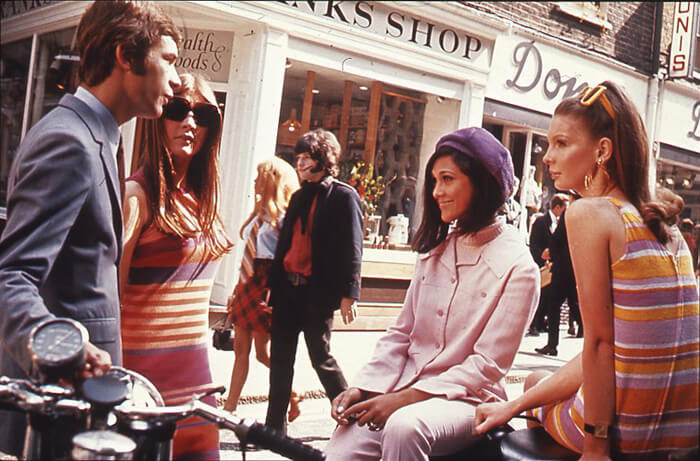The Swinging Sixties was a time where teenagers started to rebel against authority. Popular culture, music and fashion changed drastically in the 1960s. The Swinging Sixties was also known for starting a new social movement, called the hippie movement.
Context
After the Second World War, and well into the 1950s, there was austerity. Austerity means that government raises taxes and limits it’s spending so it can pay off it’s debts.
Until the 1960s, teenagers didn’t usually have any money of their own that they could spend. But teenagers started being given “pocket money” by their parents, allowing them to spend their money however they wanted – without their parent’s permission.
What happened in the Swinging Sixties?
In the Swinging Sixties, there was a “cultural revolution” where political and cultural views changed, largely led by young people. Examples include the growing anti-nuclear movement (which wanted nuclear weapons to no longer be made or used) and changing views on relationships.
Culture
The Union Jack, the official flag of the United Kingdom, was used as a symbol during the Swinging Sixties. It was put on cars, clothes – pretty much anything that could have a Union Jack on it probably did!
Fashion
The Swinging Sixties introduced many new fashion trends, including the miniskirt and the gingham dress. Most of the new trends were meant to rebel against what their parents thought was acceptable.


Men’s fashion in the 1960s included collarless jackets and slim trousers with heeled boots instead of shoes.

Music
Popular music at the time was mostly pop and rock bands, such as The Beatles, Rolling Stones and The Kinks. Many of these bands also became popular in the United States. This was called the “British Invasion”.

Where did this “cultural revolution” happen?
Most of it happened in London, known back then as Swinging London. Shopping areas such as King’s Road, Kensington and Carnaby Street were iconic at the time.

The hippie movement
The hippie movement grew in popularity in the late 1960s in the USA and spread to other countries, including the UK. Hippies wanted to break themselves from restrictions imposed by society and find a new meaning to life.
What did hippies usually wear?
Hippies usually wore brightly-coloured clothes with unusual styles. These included bell-bottom pants and tie-dyed clothes. Men usually had beards and women usually wore very little, if any, makeup. Both men and women either wore sandals or went barefoot.

How did hippies live?
Hippies usually didn’t have many things, so they could move places at any time. Hippies didn’t usually worry whether they had enough money, and they welcomed guests without any notice.
Some people lived entirely in vehicles, like the one below, so they could move around easily.

What did hippies believe?
Hippies believed in many political causes, including:
- The Campaign for Nuclear Disarmament: a movement that supports abolishing nuclear weapons in the UK and around the world. It still exists today, and the former leader of the Labour Party, Jeremy Corbyn, is a member of the movement.
- Opposing the Vietnam War: Hippies were pacifists, meaning they didn’t believe in any wars.
- US Civil Rights Movement: Many hippies joined in at civil rights protests. The US Civil Rights movement aimed for equal rights and freedoms for everyone, regardless of the colour of your skin. Before the 1960s, black people were heavily discriminated against.
- Love whoever you want: Hippies believed in loving whoever you wanted, whether that be a man, woman or even both. In the 1960s, loving someone the same gender as you was looked down upon by most people in society.
